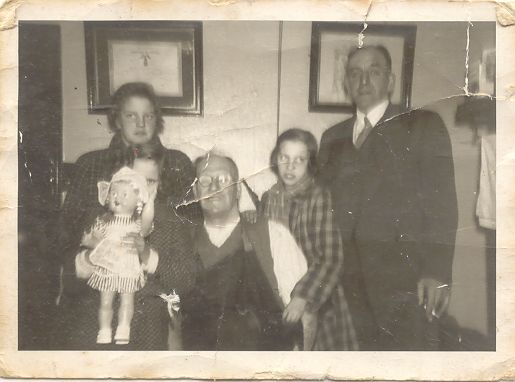Alfred Millett
Date of birth: 1885
Area: Pontefract
Regiment: King's Own Yorkshire Light Infantry then Royal Engineers
Family information: Son of Alfred and Alice Millett, husband of Mary Ann Butler(?), living in Pease's Yard, Old Church, Pontefract
Rank: Sergeant
War Service
My Grandfather, Alfred Millett at age 29 enlisted early in the war on 3 November 1914 as shown by his medal card.
First of all, he was in the King’s Own Yorkshire Light Infantry (KOYLI) and then transferred to the Royal Engineers to become a sapper in 256 Tunnelling Company, as ex-miners were the obvious choice for tunnelling companies. The 256 was the last tunnelling company to be formed in July 1916. It served first at the Vimy front and then moved to Nieuport in June 1917 to construct shelters and wells. It became involved in enemy attacks in July 1917.
Alfred went to the front 18 February 1915(medal card) and we know from a newspaper article that he was wounded in June 1915 and gassed in November 1916.
All was not doom and gloom, however, the Pontefract Advertiser 25 November 1916 reports that Alfred had received high commendation for gallantry at the front. Apparently on the 22 October, Sergeant Hardy and three men were about to enter their dug out when a shell struck the spot and buried them. When the men had been recovered, it was found that the fumes from the explosive had overcome Sergeant Hardy, but men from 256 Company had administered oxygen and brought him round.
The medical officer certified that without this prompt action he would not have survived. Brigadier-General E W Baird wrote to the man’s commanding officer-“ Will you please convey to 82985 Sapper A Millett my appreciation of his conduct?”….”he deserves a mention on his sheet.” and Major W T Wilson endorsed this recommendation with the additional tribute that “ Sapper Millett has already distinguished himself under very trying conditions in the front line trenches.”
Alfred was a past pupil of the Army Mine Rescue school and possesses a certificate showing that had passed ”very good” in the use of the proto and salvus breathing apparatus, in his knowledge of oxygen reviving and of practical work in the galleries. The paper adds that “it must have been very gratifying to him to have been thus able to put his knowledge to use and to his friends to find his skill and gallantry officially recognised.”
Another report in the Pontefract Advertiser on 21 July 1917 relates, that as well as the honourable mention for his rescue work he has also received the French Medaille Militaire. It is not yet known why he was awarded this medal. Alfred was wounded again around 16 April 1918 and was sent to Woodside hospital, Glasgow. Despite all his sufferings over the years in the trenches, he recovered.
Family Life
Alfred was born in 1885, the eldest son of Alfred (a coal hewer in the 1901 census) and Alice Millett (nee Clegg) of Newgate, Tanshelf. Pontefract. According to the 1901 census, Alfred and Alice Millett had three sons (who were all at the front) and one daughter Ada aged 13 in 1901. It must have been a very stressful time for the family back home waiting for news of the boys.
Their worst fears must have been realised when news came that his youngest brother, Private Arthur Millet, aged 18 of the 3/5 KOYLI, was killed in action June 1915 and that Alfred was wounded.
His other brother, William, aged 23 who had been a miner at Ackton Hall colliery and enlisted August 1914 to the KOYLI 1/5 Battalion and went to the front just after the death of Arthur in July 1915. According to a newspaper article he was at the front continually until June 1918 except for two leaves, one at Christmas 1916 and New Year 1917.
The news came in April 1918, that since the 4th of that month he was missing. Was he dead or captured? Then eventually in June 1918 his wife, who resided in 5 Richmond Terrace, Northgate, Pontefract, received a postcard informing her that he was a prisoner of war at Limburg in Germany.
Before the war, Alfred also worked at Ackton Hall colliery .He was married and his wife lived at Pease’s Yard, Old Church, Pontefract. However, little is known about his wife, the family did not talk about her. Evidence from the index to births marriages and deaths implies that she was Mary Ann Butler and that they married late 1905.
She must have been busy on the home front looking after the children. Alfred, my father was born in 1910 and he had a younger brother, Robert probably born in 1912 and an older sister, Hilda, probably born in 1906. She married Ernest Booth who was the landlord of the Junction Hotel, Castleford They had one son, Geoffrey
My father Alfred married Emily Anne Baxter in 1933. They had four children- Kenneth (now deceased) me (Barry), Sandra and Mary.
Alfred returned form the war, blind in one eye, possibly due to the gas attack on the Western front. He became involved with St Dunstan’s, a charity for blind ex servicemen and women.
Every miner who went to war and worked for Lord Masham, the proprietor of Ackton Hall Colliery, received a gold watch, which remains in the family.
I remember that my grandfather played the violin and had a good sense of humour. During the Second World War, he used to bake Cantatalin Tarts for the children. They were probably his own recipe based on the ingredients he could obtain on rationing. We soon ate them up- to us war-starved children they were great!
 Alfred, sitting down, his son Alfred and his two granddaughters
Alfred, sitting down, his son Alfred and his two granddaughters

